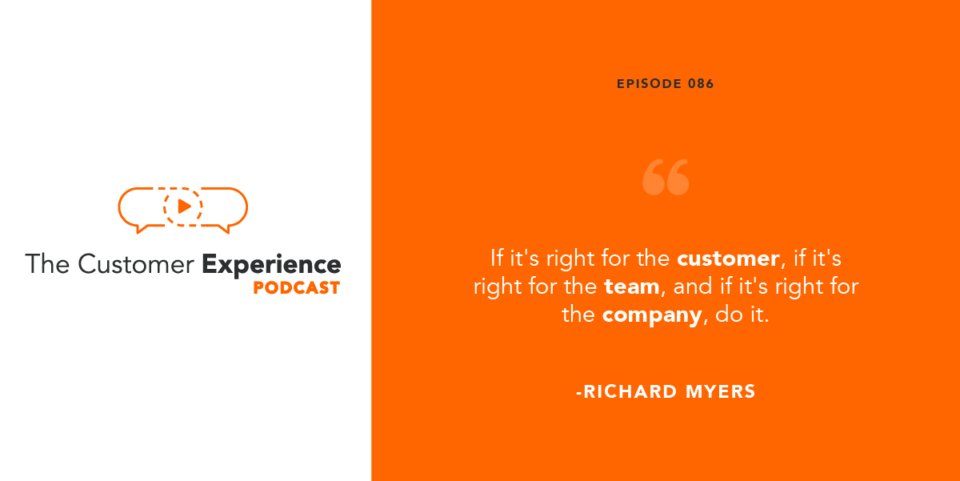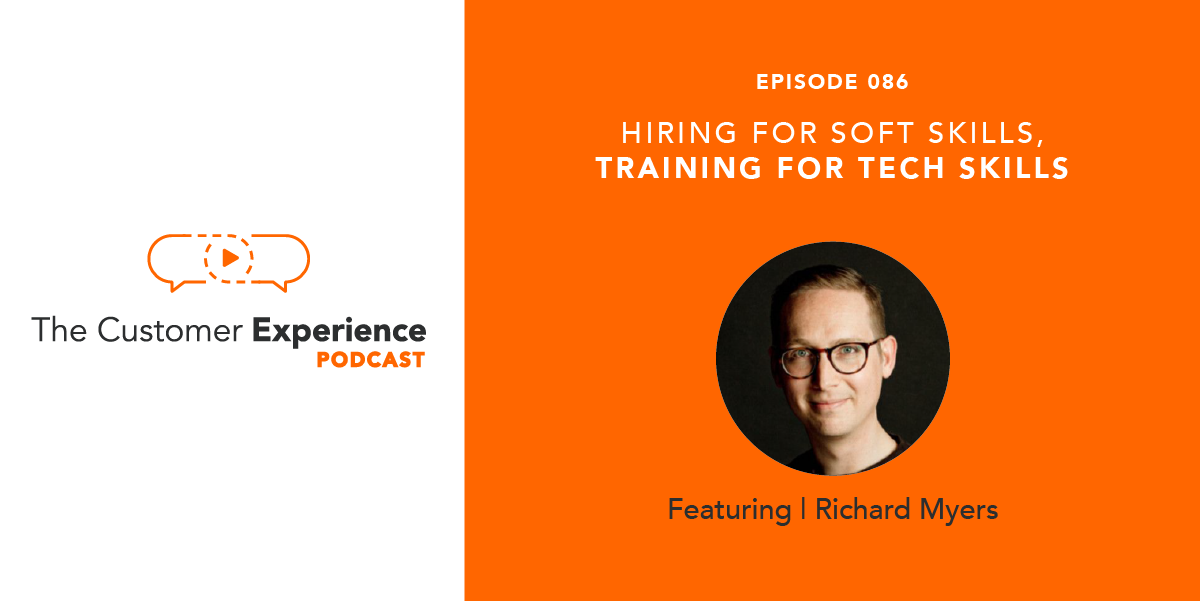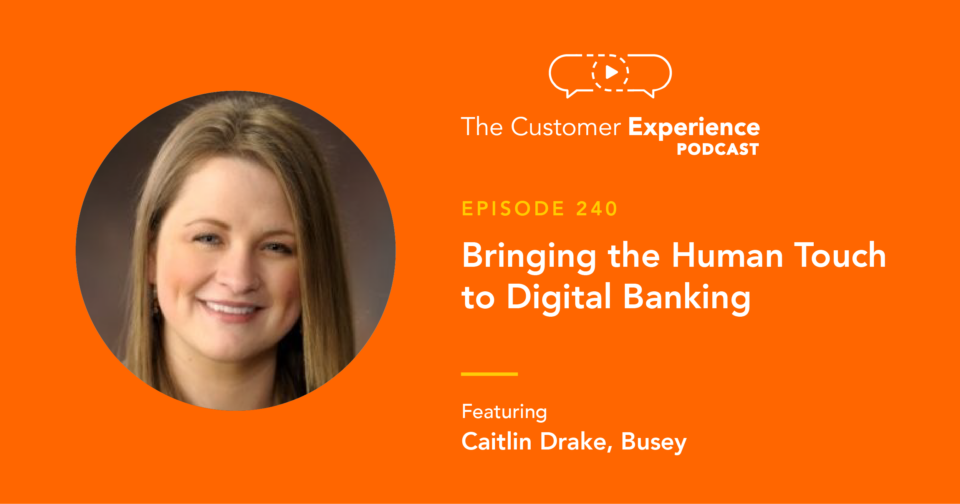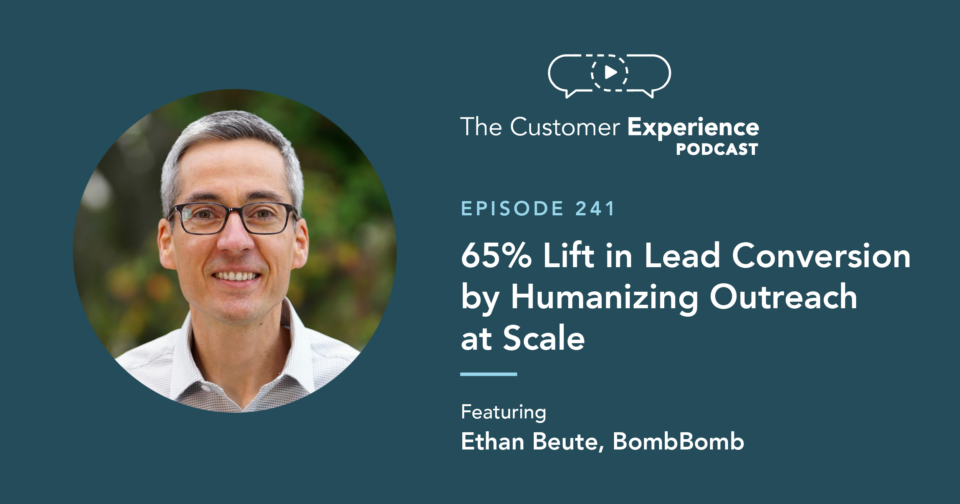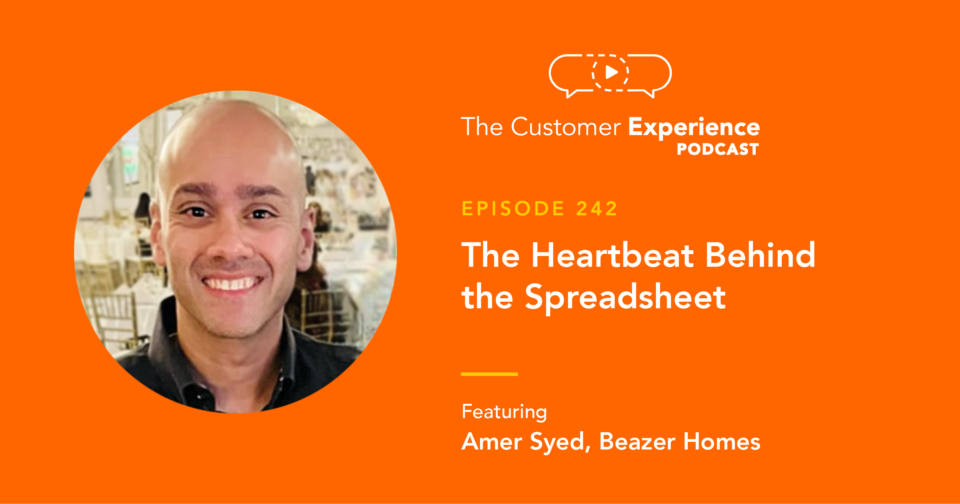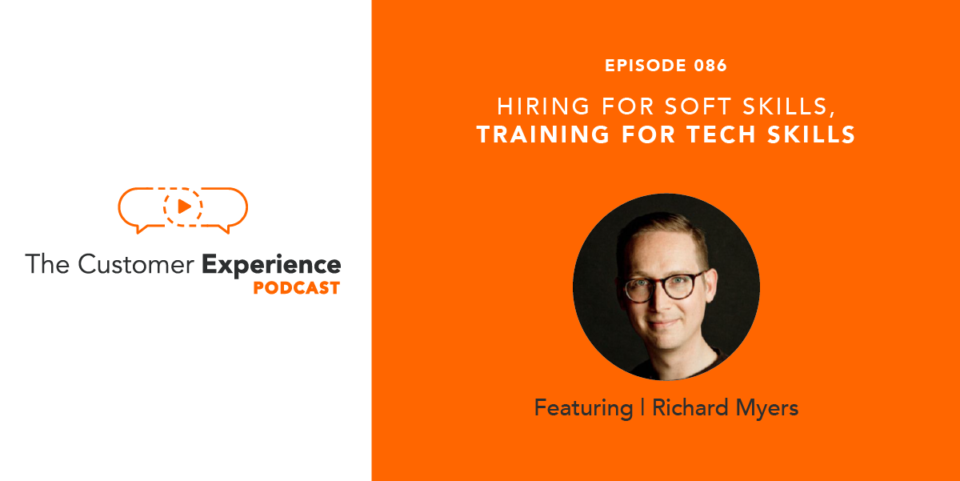
Listen to “86. Hiring for Soft Skills, Training for Tech Skills w/ Richard Myers” on Spreaker.
Apple Podcasts | Google Podcasts | Stitcher | Spotify
When you want to hire, onboard, and ramp sales reps to quickly hit quota, you initiate a sales enablement program. But what do you do when you need to do the same with customer service?
When you have a product that is highly technical, it might feel like you need engineers to run your customer support team. So where do you go to consistently find lots of people who posess that incredibly unique combination of deep technical skills and winning soft skills?
You don’t. Instead, you build a phenomenal team out of chefs, roofers, and social workers.
If you’re like today’s guest on The Customer Experience Podcast, Richard Myers, you’ll realize that training for tech skills is much easier than training for people skills. We’ve all heard of
If you commit to hiring people with diverse backgrounds in all kinds of customer-facing roles – and provide them with thorough training programs – you can hire more of them more quickly. This means your business will win … because your customers will win.
Richard is the Vice President of Customer Support and Customer Success at Linode, an independent open cloud provider that makes cloud computing simple, affordable, and accessible to everyone. In nearly a decade that he’s spent with Linode, he’s held 6 roles in customer service, support, and success – from frontline to VP.
When he discusses his search for soft skills in new hires, his commitment to internal hiring, his reorganization to build curriculum, and his weeks-long training and mentorship program at Linode, Rick is speaking from a deep well of experience in CS.
In this episode, we discuss…
• Why it’s important to hire for human skills, not tech skills
• How to create continuing education based on support feedback
• What the benefits of hiring from diverse backgrounds consist of
• What Richard’s six-week training program looks like
• Why training staff and structure is important
Hiring for Soft Skills, Training for Tech Skills
Hear the entire conversation with Richard Myers right here:
Listen to “86. Hiring for Soft Skills, Training for Tech Skills w/ Richard Myers” on Spreaker.
Hear this episode of The Customer Experience Podcast – and many others – by subscribing to in:
While you’re there, please consider subscribing – and adding a rating or review. Just a minute of your time is VERY helpful to the podcast!
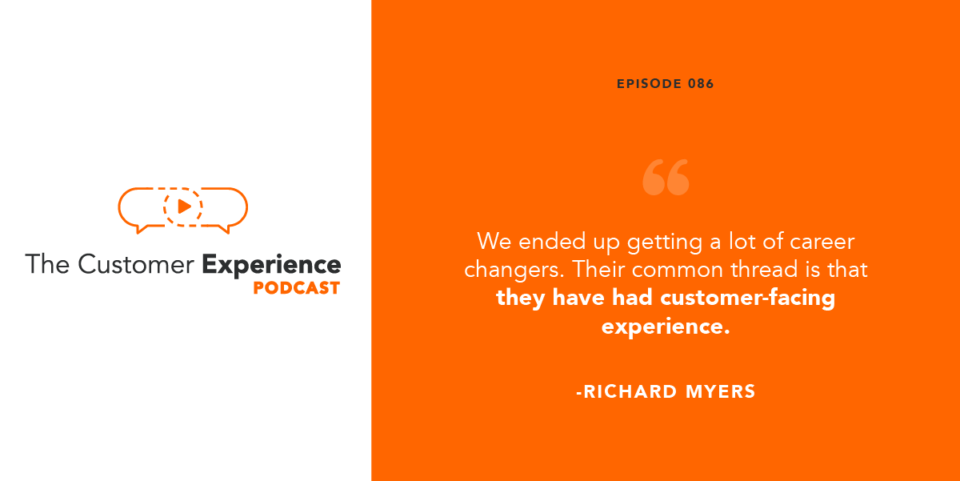
Full Transcript: Hiring for Soft Skills, Training for Tech Skills
Ethan Beute:
The good news, your customer base is growing fast, faster than you’re hiring into your customer support team. The not so good news, all of these new customers still need some support and self-service support options aren’t much slowing down the ticket queue. Plus, your customers are highly technical, so hiring and ramping people to support them can be a challenge. One of your competitors is Amazon, so the entire customer experience must be excellent.
Ethan Beute:
Today’s guest faced this problem and he’s here to share with us his solution. He spent nearly a decade with Linode, the largest independent open cloud provider. They make cloud computing simple, affordable, and accessible to everyone to help foster innovation and to help people build cool stuff. My favorite thing about his tenure with Linode is that he spent it in six different roles, progressing from a frontline customer support specialist, to currently Vice President of customer support and customer success. Rick Myers, welcome to the Customer Experience Podcast.
Richard Myers:
Thanks, Ethan, thanks for having me. This is really exciting.
Ethan Beute:
Yeah, I’m really excited to get into your story. Before we do, we’re recording this in Mid-may, it’s not going to release until sometime in the summer, but I’m in Colorado, you’re in Philadelphia. What’s the situation there with regard to the coronavirus pandemic? How is it affecting you or your team or your customers? Just give me a quick pass on what’s going on for you.
Richard Myers:
Sure, we were already partially remote, so from a workplace perspective and from a remote working from home perspective, it hasn’t been too much of a change for us. We just transitioned into complete work from home. There’s been challenges around that, I think mostly socially or just not being able to see people. That’s happening in your personal life as well so it’s even harder. What you wouldn’t get from working in the office, you would usually get with your friends or with your family and you’re not getting that either. So I think it’s tough but I think that there’s a lot of positivity coming out of it too, in terms of making sure that your colleagues, your friends, your family are doing well and checking in on people a little bit more often and making more of an effort, which has been nice.
Richard Myers:
For our customers, it runs the gamut. Some people are seeing a boost in what they need because we provide an infrastructure for people. Some people need some more infrastructure, and some people are getting hit hard. So it depends on what you’re doing. Overall, it’s just very weird, it’s very strange. I think the easiest or the most healthy thing at least for me is just to take it one day at a time and try to stay off news or limit the amount of news that you’re watching.
Ethan Beute:
Really, really good call. Thank you for sharing that. I agree top to bottom with it. We just did a survey of our team members at BombBomb and it was like 78% of people gave it the most favorable rating. They love working from home, but in the verbatim feedback, the themes are exactly what you talked about but I had not thought about, we all miss our team members. We miss the spontaneous conversations, the in the hallway stuff, or the conversations you didn’t plan in your day that just make it either more fun or you get a new insight or these kinds of things that we all miss. I had not thought about the complicating factor of less exposure of course to other people, who could potentially fill that need for you. Like you, our customers are of all kinds and they’re all affected differently. Some of them are doing better than before, some are doing worse than before. So anyway, thank you for sharing that.
Ethan Beute:
When I say customer experience to you, Rick, what comes to mind? What do you think about when you think customer experience?
Richard Myers:
I think that’s a really good question. It’s almost indefinable, but when something’s in-definable, I think that sometimes it helps to frame it as a feeling. I think that that sums it up. Your customer experience is a feeling that customers have when they’re interacting with you or when they’re just thinking about you or considering you. I think that that experience and their feeling comes down generally to how easy or pleasant it is to deal with your company.
Richard Myers:
Easy and effort are the same thing to me, so one thing that we focus on a lot at Linode is customer effort. We measure customer effort, that’s how we measure our interactions with our customer base and it makes a lot of sense to us. People are more likely to have a good experience and be more likely to want to reach out and become promoters if when they have a problem or they need something or they need to find something, it’s easy for them. That effort is very low. I think that one of the other parts about measuring effort or ease is that it works everywhere in the customer lifecycle from pre-sales to purchasing to onboarding, using the product, getting support. There’s things you can do in every part of that that help lower customer effort and create more effortless experiences. So, when I think about customer experience, it’s really about how easy it is to use or consume your product or your support for your company’s offerings.
Ethan Beute:
Love it. The two layers there, they’re super, supercritical and they’ve both been themes. It’s why I always like asking people from different disciplines the same question, is frictionless or ease, and then the feeling. The experience itself leaves you with a feeling and that is the foundation for all the things that happen from there. How do I think about it? What decision, do I repurchase? Do I renew, do I expand, do I refer? All those other things, it all starts with the feeling that you leave people with. So, one observation there.
Ethan Beute:
Talk about measuring effort. How do you measure effort?
Richard Myers:
Yeah, we use a customer effort score, which is sort of a competitor, or sometimes used side by side with NPS or CSAT, just another customer satisfaction metric. So the way that we do that with customer effort is just surveying customers after an interaction and literally asking the question, “How easy was it to solve your problem?” I think the problem with every customer satisfaction methodology is the question. So, some of them better than others, some of them better than others just in design. NPS asking whether or not you prefer a friend or a colleague to use the service or customer effort, asking how easy. It really depends on someone literally answering that question, as opposed to maybe the default feeling where I just want to answer how happy I am right now. So, it’s really important that that actual question gets answered to be able to measure it.
Richard Myers:
When you dig into the comments and when you dig into the ticket that it came from or the phone call that it came from, you can get a feeling of like, okay this was really answering a question of effort or maybe it was just more like, I’m upset or angry or what have you, something that may or may not be within your control. But yeah, surveying through tickets that are closed.
Richard Myers:
We also, side by side, measure CSAT. We do that for a different reason. We use that for each update in a ticket so we can identify issues early in a conversation and intervene and ride the ship before the ticket’s closed or the phone call gets answered or what have you.
Ethan Beute:
In your opinion or experience, what is the relationship between CX and CS?
Richard Myers:
I think that CS has a big responsibility in ensuring that you’re having an appropriate customer experience. There’s a lot of it that’s within our control. It’s how you talk to customers, how you solve problems, how easy it is to solve problems, how quick you answer a customer’s phone call, and stuff like that. But there’s a huge chunk of it which is just in taking information that a customer support team may not have control over. Collecting feedback, putting it in the right place, getting it to the right people, and then closing the feedback loop afterward too. So it’s unique, the responsibility CS has over CX because there is a chunk that we can teak care of but being the team or one of several teams that talk to customers, there’s a much bigger responsibility to customer experience than just being the liaison between the customer and the teams that can change the experience.
Ethan Beute:
Yeah, really good. Those last two steps there, getting the information to the right people and closing that feedback loop is really where so much value could be I guess retained, rather than just wash out of the organization, because we’re all collecting this information but the collection is not nearly as useful as doing something with it. That was really good.
Ethan Beute:
For folks who aren’t familiar, before we go farther, just give me a quick take on Linode. Who are your customers generally? What do you do for them, what do you solve for them?
Richard Myers:
Yeah, Linode is a cloud computing company, so we provide infrastructure. Our customers run the gamut. We give you the primitives to build to things on. What our customer do with it, is everything from just running a website, or running a mail server or a game server, all the way up to being the complete infrastructure backend and front end to a very large web application or appliance or something else. So really does run the gamut from the smallest to the biggest thing.
Richard Myers:
We like to think of ourselves as the utility company. So we give you the components and then you can build whatever you want. We add a layer on top of that, we add several layers on top of that but one of those is a support team that will help you build those things, help you solve problems while you’re designing and building things. Just being an open ear at least or a problem solver at best, for providing guidance and solutions while you’re scaling.
Ethan Beute:
Really good, and that tees up the problem, solution scenario. The story we want to tell here, and then extract some takeaways from it. So, you have technical customers, sometimes you go beyond and we do the same thing with the way we support our customers. Sometimes we’re solving problems that are not related at all to our own software or our own offering but it’s somewhere in that zone between, the problem that they have or the goal they want to solve and if they’re on the phone with us, we’re going to help them get there. So anyway, you need some technical folks. I laid out the situation in the introduction, but briefly describe it in your own words. What was the challenge that you were facing when you went down this road of developing an internal training program?
Richard Myers:
Yeah, the first steps that we took were to solve a different problem that we ended up solving, but we ended up solving more than just that problem, which was just that we didn’t have enough people to answer all of our customer’s inquiries. So we were in a small town in New Jersey, and the type of customers that we have, the questions that run themselves to those types of customers are super technical, very specific sometimes. It’s not uncommon for a support specialist at Linode to receive a ticket or a phone call about something that they never even heard of before, but like you said, we do set really great expectations that we don’t solve every problem for you. We’re not your developer, your systems administrator, but we’re at least going to push you in the right direction and give you something, a jumping-off point to get there.
Richard Myers:
So, you have to have really great technical skills to be able to at least know what people are talking about or at least in what direction they’re going, and then also you have to have all the great support and service skills. You have to be a people person, you have to be an empath. Sometimes, those things don’t match up with everyone. There’s left brain, right brain things and not everyone has both of those.
Richard Myers:
So as we were getting underwater with our wait times, something had to change. When we thought about those two very general skillsets, the technical part, and the support part. We thought well, one of those things is far more easily taught than the other, and that’s the technical piece. So our hypothesis was that if we can get people who have great customer support experience, have great customer service experience, and have an aptitude towards the technical side of things, well maybe we can vest in an internal training program to get them up to speed there. We don’t have to worry about the other thing that’s way harder to teach. We can increase the pipeline so much, the amount of people who are coming in, that we’d have all these candidates and we’d be able to hire more people and get back to the time we first respond, that our customers come to expect. We wanted to deliver. That’s what we ended up doing.
Richard Myers:
The results of which have been astounding. They’ve been better than we thought it would be, to be honest.
Ethan Beute:
I really like this divide you realized. I’ve encountered this many times, I’ve hired a lot of different roles throughout my career. There’s always this trade-off you have to make, typically with a lot of roles, especially early on when you need someone that is a little bit more general. So you’re going to say, “This person needs to be able to design and develop, which skill am I going to favor in this scenario?” So for you, it’s all the natural CS stuff, problem-solving, empathy, a passion for helping people, et cetera. Then of course this deep set of technical skills. So I love that you just walked it down, got honest with yourselves, and said, we’re going to favor this side and teach the other side.
Ethan Beute:
So, take it from there. How far away from technical skills were some of these folks? What were some of the first steps to helping bridge that divide so that they could listen, talkback, ask good follow up questions, and instill… this is a really interesting part of the CX feeling in my opinion, is people feeling confident that you are the right solution for them. Obviously, and you already established, your team is the frontline team. They are someone that the customer directly interacts with, so you want to leave them with this feeling of confidence as well. So, talk about what it takes to get the raw material you were getting favoring the CS skills or the people skills or the empathic skills. How did you get them technically adept?
Richard Myers:
Yeah, the first thing that we set out to do was to create a curriculum of what we needed to teach people, which that feels like a really easy task. When you set out to do it and quickly becomes the most intimidating thing that you’ve ever tried to do because just the vast, wide subject matter that you have to cover. You don’t think about that because when you have the prerequisite knowledge, then that lends itself to figuring out the more obscure or specific things, but we weren’t even starting with that level of knowledge. So we have to go layers backward to be able to teach the things that we thought you had to know. There was no basis, there was no foundation for our curriculum.
Richard Myers:
So, we dug back, we created a curriculum that’s still evolving today, but we surrounded it all around our set of core values that we’ve had for a long time. Which, did something special in that it empowered our frontline support agents to not have to know everything but it empowered them to be able to know where their resources were and to ask questions and to split problems, so we knew exactly what we were looking for. It’s because we had to go a couple layers back, we started not with the most technical thing but really, how to dig all the way down and then build back up to get to a solution. That’s still evolving today, we’re still finding holes and opportunities for education with continued education.
Richard Myers:
The cool thing about creating a curriculum is that it also rendered itself to creating modules. So you can take a module and say we’re talking about web servers today. You can just teach that web server module that day, but that also means that you can pluck that out of the onboarding curriculum, our six-week training, and you can run everyone on the support team through that module again as a continued education class because we’ve identified that. For example, our ticket categories, our tickets that have been categorized as web server questions, have a very low CSAT score, so we know that there’s opportunity there. There’s the low CSAT score, that there’s high time to first response or it takes a lot of updates for us to resolve the ticket. So, that was an unforeseen advantage that we had by doing it that way.
Richard Myers:
Your other question was really interesting. The type of people that we started getting. What we have ended up getting are a lot of career changers. So we have social workers, we have chefs, we’ve had roofers, we’ve had equestrians, all kinds of people but their common thread is that they have had a customer-facing experience in one way or another. We’ve assessed that they can talk to people and they have that piece, but maybe when they got done their job roofing or social working, whatever it was. Those were the people who were going home and they were fiddling around with the computer. They were messing with servers, they were messing with Linux, they were hobbyists and maybe they were hobbyists for a very long time. We could interview to be like, to get to the point where you’re like, okay this person has the baseline. Let’s accelerate them up to where they can answer our customer’s problems. That group of people have made our team so much better than what we could have imagined just hiring technical people with some customer service background.
Ethan Beute:
So many follow up questions for you that I’m excited about. I’ll just say them so that we don’t forget. Maybe we hit them all, maybe we don’t. One, I’m curious about your core values, two, I would love to know the shape or the depth of the curriculum at this point. I assume you’ve been undertaking this for a couple of years now. So, what are the prereqs, and is it… in my mind, it’s this fully developed curriculum. Then the third category I’m interested in is where you just are there. I mean you have this diversity of background experience I would assume, diversity of age perhaps, and maybe the values and benefits of bringing all those people into one team and how many maybe unexpected positive consequences came from that.
Ethan Beute:
So, give me a quick pass on your company core values.
Richard Myers:
Sure, so our core values are a mix in between a mission and vision statement, and also the how behind the behaviors that exhibit that mission and vision and values. So, they run everywhere from we come to work being better than we were the day before. That we create the environment we want to work in. All the way to very specific things like we read a ticket fully and understand it before we answer it, or that we answer every individual question in a ticket, or that we admit our mistakes and we’re honest with our customers and tell them that we might not have an answer. I think that goes back to what we were talking about a minute ago about setting expectations and also our scope of support, which it sounds like we’re both familiar with customers who reach beyond our scope of support. How to deal with that and how to tell a customer, “I am 100% here to start you off and to lead you in the right direction but we’re not the people that are going to be able to answer that question for you. But, here’s how to get started.”
Richard Myers:
So, our core values, we really do live and die by them. We say we hire and fire by them. They are the lifeblood of what we do, but the core purpose of them is with such a big team and with the wide variety of issues that we face is, you should be able to look at a problem whether it’s a customer problem, whether it’s an internal problem, whether it’s a problem of procedure or policy, and you should be able to say, “I don’t know where to go with this.” Then look over at our core values and they will guide you to exactly what you’re supposed to do.
Richard Myers:
So, one of the most valuable ones that we have that we talk about all the time came from my time at Apple, which is, if it’s right for the customer if it’s right for the team, and if it’s right for the company, do it. You don’t need to ask questions. You’re perfectly empowered and able to do that thing if it hits all three of those items. So they really are our guiding light and drilling them and remembering them and thinking about them has been one of the most important things, one of the most important tools we’ve had to be able to scale.
Ethan Beute:
I like that alignment in particular of customer, team, company. It’s a no brainer. Just go do it, so good.
Ethan Beute:
Give me a pass on how this curriculum shaped up, and I’ll just tee it up a little bit more. I’m going to assume that this is above and beyond the onboarding itself. How are you delivering it? How much of it is, these are maybe on an internal website or these are training videos or these are in-person sessions and we do them once a month? Or, how are you teaching the material and how is the material stacked up for folks that maybe want to start imagining in a more practical sense how they might do something similar?
Richard Myers:
So our training starts right now, we are doing a training class on the first Monday of every other month. So our training class takes six weeks internally, it’s all in-person, it’s 8:00 to 5:00. It consists of videos, it consists of presentations, it consists of pre-tests, post-tests, examinations to make sure that people are understanding and retaining the data. A lot of practical stuff. So we were talking about web servers, it’s one thing to understand how web servers work, it’s another to build your own from scratch and to have it up and running and for it to break and for you to have to fix it. So, big shout out to our training team who really, really, deeply believe in practical training, and now I do too.
Richard Myers:
So, it’s six weeks, we learn everything from the technical stuff to our core values to how we interact with customers. To more basic things like, what does the marketing department do? Who’s in finance? How does product communicate with customer success? A lot of the inner workings of Linode as well as the support team at Linode. It goes six weeks, and then we move onto a mentorship. So we have training specialists who are full-time trainers. Then we have training experts who are part-time trainers. They mentor our trainees for usually around six or eight weeks. Our average onboarding time right now from the day you start until the day you’re onboarded is about 72 days.
Richard Myers:
At onboarding, what we expect is that they could take a schedule by themself. Since we’re 24/7, we have a rolling schedule. We have people staring and coming off the schedule at every hour. You should be able to take a schedule, take a shift by yourself, and have very minimal need for… not for asking questions or not understanding something or not relying on your peers, but really not knowing like, “I don’t know how to do this. I don’t know how to do this thing, I don’t know how to find this resource,” or what have you.
Ethan Beute:
Really good, I love the full scope of the organization as an element of it because that’s consistent with the, is this good for my team? You obviously know if it’s good for the customer, but is this good for the company and or the resourcefulness required to, if it’s, yes, yes, yes, go act on that. Just a fuller scope obviously helps people be able to do that.
Ethan Beute:
I guess the last practical question here, you mentioned a couple full-time trainers, a couple part-time trainers. How many people are devoted specifically to this training program, and how did you find those folks? Did you hire educators or were these already Linode employees who had an aptitude for this? What is just the training organization, sub-organization look like? How did you build it?
Richard Myers:
Yeah, so one of the things that I am most proud of our team for doing since Linode started, we’ve had a commitment to internal promotion. So, in the support team specifically, we actually make very few outside hires. Almost everyone has come in as a support specialist, and then grown into another role. A lot of those people have grown into other roles outside of the support organization into other roles, such as product development or marketing and documentation, all kinds of stuff. That’s something that we’re super committed to. That’s true within the department as well. All of our trainers, we have a training team lead and we have three full-time trainers. I think we have six training experts, all of those people started as support specialists and have grown into that role.
Richard Myers:
Some of them have backgrounds in education or training. Our training team lead was a trainer at Apple. A lot of our team came from Apple, we take a lot of liberty in taking things from Apple because they do customer support so well, obviously. But all of our trainers were in the support organization, they went through the training program. They experienced training themselves, found opportunities, and then in time as they developed those competencies for training and education, they were promoted into training roles.
Ethan Beute:
Really good, I guess the last element that I would like to double back on is again, you’re hiring people from a wide variety of backgrounds based on the core set of skills that you want to see. Then obviously, using the core foundation. I’m sure these trainers are continuing to build modules and update modules and those types of things. Talk about the benefits of getting people from a variety of backgrounds. I mean I would assume that there are some… it’s probably a little bit more fun, a little bit more interesting and there’s probably some benefits to the rest of the team.
Richard Myers:
Yeah, when we started this training program, we were looking to get more people but what we ended up getting were people from backgrounds and careers that we would’ve never considered before. The diversity of backgrounds and diversity of thought has manifested itself in by far the best team we’ve ever had because there’s no need to explain why these things are good, but when you see it in action and you see that someone came from a career where they did something tangentially similar but they had a different take on it because of that industry or because of their needs or what have you that you would’ve never even considered. They can come in and have those conversations and impart those experiences on us where we’re so much greater than the sum of our parts now because we’re not all the same, we didn’t all come up doing SAS support or what have you.
Richard Myers:
We didn’t expect that we didn’t necessarily shoot for that to happen. We knew that we get a more diverse candidate pool, but the effects of those things just can’t be described. It’s unbelievably beneficial for us to have this really unique support team, that I don’t think a lot of other support teams look like that.
Ethan Beute:
Yeah, it’s good. Ours is not, we have a diverse set. Like you, there’s so much kinship here. So for folks who are listening, if you know someone who fits some of these softer side skills, the human skills, and they’re out of work right now and there are a lot of people out of work. There are a lot of SAS companies that are successful even in this environment that are growing. While your program is absolutely unique, I know that there are opportunities for people that listeners may know to engage in a company that may not be as good at it as you all are, it might not be as formal or well developed, but people are looking for good people. I think good hiring managers, good managers, and effective business builders recognize what they can train and what really needs to be inherent in the person from the get-go. So, there might be opportunities for you or people you know if you’re listening to this, that were maybe unexpected before. I don’t want that to be a missed opportunity.
Ethan Beute:
Like you, we have hired out of Apple. I’m thinking of a couple employees at BombBomb that we hired out of Apple and they have great onboarding and training. So you know you’re getting just some really good habits that are built. Another place we’ve hired well out of in support and elsewhere is Starbucks. Starbucks is very, very formal, and highly repetitive. So some of these customer service skills are good. There’s a company out here all over the west called Dutch Bros Coffee. I had a couple of their VPs on this show several months back. Same thing, they have a very aggressive program of building into people. Not hiring this role or managing this role, but building into people. So there are a lot of opportunities out there, and I really appreciate what you’re doing with your team. I’m glad to hear that A, you were able to overcome the problem that you were facing immediately. B, that it provided so much growth and benefit.
Ethan Beute:
I also love, you answered several questions that I had just in passing. I just think it’s really cool that you’ve been in six different roles and obviously you spoke to that, not necessarily as an explicit core value but as definitely a deep, natural way of operating within Linode is like, we want to do internal growth. You’re obviously a great example of that. I was also going to ask about being a Mac genius, and it sounds like you’ve got several of them in house.
Ethan Beute:
So, before we move on a little bit, is there anything else you want to share about that program? Anything I missed, anything I failed to ask or something really interesting that you learned or surprising that you learned that you think might be helpful for folks? Whether they’re in CS or sales or marketing or elsewhere.
Richard Myers:
Yeah, I think the only other thing to touch on is, I think this used to be a commitment through your department beyond the onboarding and training and continuing education. I think there’s a lot of value in creating levels and what we call, expert roles. So we have a number of expert roles, the support team actually consists of support, trust and safety, community, quality control, training, and customer success. All of those have full-time roles, but they also all have expert roles where you can do that part-time, in addition to your support work. You can move into full-time roles as well.
Richard Myers:
We also have levels, so there’s support level one, two, three, four. There’s senior support level one, two. There’s customer support managers. I know you have to grow to be able to justify that number of roles vertically, but I think there’s a lot of opportunity to do this horizontally as well with part-time expert roles. Giving people exposure to other parts of the business, whether or not it’s in your department, is another great avenue for growing people, which we know is good for the company as well as the individual. So, the training organization if you have one or if you’re considering building one, that’s the launch point, is onboarding. But there’s so much more you can do afterward too to continue to facilitate that growth vertically, horizontally, in the department, outside of the department, and contribute to the company as a whole.
Ethan Beute:
Really good, I mean I thought about several things during the conversation. I love that add there at the end. I was thinking, it would probably be beneficial for a salesperson to go through some of these modules and these kind of things…
Ethan Beute:
I love this cross-functional exposure. We’ve had some… it sounds like you’re doing a lot of things that came naturally to us but you’re doing them in a much more advanced and developed way and that your team’s probably bigger than ours as well, but this is great. In fact, that up and down, side to side cross-department training sounds like another good conversation we should have here on this show, but we’re basically at time. So I want to let you get back to your day and let listeners get back to their day because there’s been tons of great information in here.
Ethan Beute:
If you’re listening and you’ve enjoyed this conversation with Rick, you might also like episode 32 of The Customer Experience Podcast. On episode 32, I talk to Luke Owen, who is the former Director of CX at Formstack and he’s currently the Principal CS Specialist with SaaAWorks. That one was called, Meeting Customers’ Evolving Needs with a CX Team. The reason I thought of that one is that it really is this, a little bit of blocking and tackling. How do we build the team? How do we structure the team?
Ethan Beute:
Then another one that came to mind is episode 51 with Joe Caprio, former VP of Sales at Chorus.ai, and now a founder at Reprise. That one was called, How to Enable Your Sales Team, Practical Tips for Sales Leaders. There, we talked a lot about sales enablement and sales-readiness. In talking before we had this conversation, Rick, this made me think about CS enablement. This is a CS enablement layer because sales enablement isn’t just equipping salespeople with great slide decks and PDFs and other things they can send out, it’s really training. There’s a training and development layer to it. Feedback loops and building people up that I think folks might like Joe’s perspective on a similar topic, but more from a sales seat.
Ethan Beute:
So, Rick again, thank you so much. Before I let you go, I’d love to give you two opportunities. The first one is to give a thank or a mentioned to someone who’s had a positive impact on your life or your career. The second is to give a shout out or a nod or a mention to a brand or a company that you really respect for the way they deliver for you as a customer.
Richard Myers:
Yeah, I had thought about this and one person came to mind very quickly, which was my old boss and mentor, Steve Clemens. When I started at Linode like you said, I was a support specialist and I had worked plenty of retail jobs and support jobs, but Steve was my first boss who took an interest in helping me learn the business side of things. I had not had experience with the higher-level considering a lot of the stuff that the executive level, the C Suite directors need to think about. That was the first time I was exposed to any of that stuff. It’s not something that you always get taught, or you always have the opportunity to teach.
Richard Myers:
I like to think, I like to tell people when you’re in an entry-level position, all you have to think about is the customer. Right? Then if you’re a CEO or on the board, all you need to think about is the bottom line. Now, this is a huge over-exaggeration and that’s not true, but as you move up in the organization those ratios change. He was the person who helped even kick start learning that side of the business, which I had never had exposure to. We’re still great friends, a great mentor and I just wanted to shout him out because he deserves it. So yeah, Steve.
Ethan Beute:
Awesome. How about a company that you appreciate or a brand or someone that’s giving you a great experience as a customer?
Richard Myers:
The most recent great… I live for great customer service experiences. They make me so happy, I get so excited when I have one. I have to call that person’s boss and tell them, it’s absolutely what motivates me day in. The last one I had was with a company call B&H, they say audio, visual, photo equipment in New York City. I had ordered a pack of photo development paper for a gift and it came on my doorstep before Christmas, on Christmas Eve, and it was soaked, soaked to the bone. I’m sorry, it was the 23rd. It was no one’s fault, it just got left out in the rain. I called them and I said, “I really need to have this tomorrow, it was a Christmas present.” No questions asked, no prodding on my part, they said, “Okay, this is how we’re going to do it.” They didn’t make me tell them what I needed, they told me what I needed to do. Then they went above and beyond and said, “We’ll take care of shipping, don’t worry about it we’ll send you another box. You can send the other one back.” Their number one concern was me having that Christmas present in time.
Richard Myers:
Going back to what we talked about in the very beginning of this conversation, they made it so easy. It was completely effortless, so that was my last great customer support interaction.
Ethan Beute:
Awesome, I send people to B&H regularly when they want to move beyond their webcam for doing videos and things. I say, Amazon is a great place to get volume reviews but when you want to get the hardcore reviews, you go to B&H, they have a great catalog, it’s organized well. I’m really happy to hear that story.
Ethan Beute:
Two things that stand out to me in particular. One is that your goal was their goal. They made their goal your goal. Get a Christmas gift in great shape before Christmas to the customer. So, that just being aligned there. Then the other thing was, they didn’t… and I see this in so many cases, not just in a support scenario, but it’s like a lot of people come with this, “How can I help you?” Versus, “Hey, here are a couple ways I think I might be able to help.” Right? Again, that’s just removal of friction, it’s so much easier. It’s like, are you thinking about this or that? Well kind of this, but a little bit more… walk me down the road, help me a little bit instead of this wide open, “How can I help you?” How can we make this good? They’re like, “Hey, we’re going to do this. How does that sound to you, Rick?” You’re like, “That sounds fantastic.” So good, great story. I really appreciate it. I really appreciate your time. Congratulations on your success.
Ethan Beute:
Linode is obviously doing things very, very well for their customers, for your growth, but then also for the team members for someone like you who has stuck around for years continuing to learn and grow, be a part of initiatives like the one that we talked about at length today. It’s just awesome, so thank you for sharing that with us. If people want to follow up with you Rick, or with Linode, where would you send them?
Richard Myers:
My Twitter is probably best. It’s just, RickatLinode. Rick, A-T, Linode. I have a website as well, Richardmyers.me. LinkedIn, you can find me on there and Linode’s, at Linode.com. L-I-N-O-D-E.
Ethan Beute:
Awesome. I will link all that stuff up at BombBomb.com/podcast. I will also link a great blog post that Rick wrote on this topic up there as well. So, on any of these episodes, if you enjoyed them and you want to learn a little bit more, you want to see some video clips, you can always visit BombBomb.com/podcast. Thank you so much for listening and again, Rick, thank you so much for your time. I appreciate it.
Richard Myers:
Thanks for having me, Ethan.
Video Highlights: Hiring for Soft Skills, Training for Tech Skills
Check out the top five video highlights from the discussion with Richard Myers of Linode below…
1. Hiring for Human Skills, Not Tech Skills
2. Continuing Ed Based on Support Feedback
3. Benefits of Hiring from Diverse Backgrounds
4. The Six-Week Training Program
5. Training Staff and Structure
Links Related to Our Conversation with Rick:
- Why You Need a Support Training Team
- CS Leader Stephen Clement on LinkedIn
- B&H Photo, Video, and Pro Audio
- Rick on LinkedIn
- Rick on Twitter
Similar Episodes Of This Podcast That You’ll Enjoy:
- “Meeting Customers’ Evolving Needs with a CX Team” with Luke Owen (Director of Customer Experience at Formstack when recording, Principal Customer Success Specialist at SaaSWorks today)
- “Training and Certifying Your Sales Team to Speak Your Customer’s Language” with Alex Rosemblat (VP of Marketing, Datadog)
- “How to Enable Your Sales Team: Practical Tips for Sales Leaders” with Joe Caprio (VP of Sales, Chorus.ai)
Subscribe, Listen, Rate, and Review The Customer Experience Podcast:
